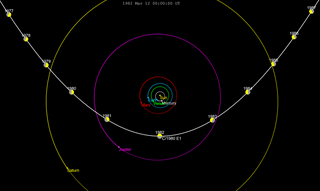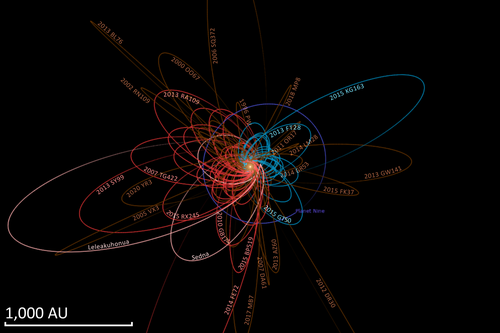
Comet Machholz, formally designated C/2004 Q2, is a long-period comet discovered by Donald Machholz on August 27, 2004. It reached naked eye brightness in January 2005. Unusual for such a relatively bright comet, its perihelion was farther from the Sun than the Earth's orbit.

(87269) 2000 OO67 (prov. designation:2000 OO67) is a trans-Neptunian object, approximately 64 kilometers (40 miles) in diameter, on a highly eccentric orbit in the outermost region of the Solar System. It was discovered by astronomers at the Chilean Cerro Tololo Inter-American Observatory on 29 July 2000.

Comet C/2006 M4 (SWAN) is a non-periodic comet discovered in late June 2006 by Robert D. Matson of Irvine, California and Michael Mattiazzo of Adelaide, South Australia in publicly available images of the Solar and Heliospheric Observatory (SOHO). These images were captured by the Solar Wind ANisotropies (SWAN) Lyman-alpha all-sky camera on board the SOHO. The comet was officially announced after a ground-based confirmation by Robert McNaught on July 12.

(308933) 2006 SQ372 is a trans-Neptunian object and highly eccentric centaur on a cometary-like orbit in the outer region of the Solar System, approximately 123 kilometers (76 miles) in diameter. It was discovered through the Sloan Digital Sky Survey by astronomers Andrew Becker, Andrew Puckett and Jeremy Kubica on images first taken on 27 September 2006 (with precovery images dated to 13 September 2005).
C/1992 J1 (Spacewatch) is a comet that was discovered 1 May 1992 by David Rabinowitz of the Spacewatch Project. This was the first comet to be discovered using an automated system.

C/1980 E1 is a non-periodic comet discovered by Edward L. G. Bowell on 11 February 1980 and which came closest to the Sun (perihelion) in March 1982. It is leaving the Solar System on a hyperbolic trajectory due to a close approach to Jupiter. In the 43 years since its discovery only two objects with higher eccentricities have been identified, 1I/ʻOumuamua (1.2) and 2I/Borisov (3.35).

2012 DR30 is a trans-Neptunian object and centaur from the scattered disk and/or inner Oort cloud, located in the outermost region of the Solar System. The object with a highly eccentric orbit of 0.99 was first observed by astronomers with the Spacewatch program at Steward Observatory on 31 March 2009. It measures approximately 188 kilometers (120 miles) in diameter.

2013 BL76 is a trans-Neptunian object and centaur from the scattered disk and Inner Oort cloud approximately 30 kilometers in diameter.
2005 VX3 is trans-Neptunian object and retrograde damocloid on a highly eccentric, cometary-like orbit. It was first observed on 1 November 2005, by astronomers with the Mount Lemmon Survey at the Mount Lemmon Observatory in Arizona, United States. The unusual object measures approximately 7 kilometers (4 miles) in diameter. It has the 3rd largest known heliocentric semi-major axis and aphelion. Additionally its perihelion lies within the orbit of Jupiter, which means it also has the largest orbital eccentricity of any known minor planet.

C/2015 ER61 (PanSTARRS) is a comet and inner Oort cloud object. When classified as a minor planet, it had the fourth-largest aphelion of any known minor planet in the Solar System, after 2005 VX3, 2012 DR30, and 2013 BL76. It additionally had the most eccentric orbit of any known minor planet, with its distance from the Sun varying by about 99.9% during the course of its orbit, followed by 2005 VX3 with an eccentricity of 0.9973. On 30 January 2016, it was classified as a comet when it was 5.7 AU from the Sun. It comes close to Jupiter, and a close approach in the past threw it on the distant orbit it is on now.
2013 RF98 is a trans-Neptunian object. It was discovered on September 12, 2013, at Cerro Tololo-DECam.
2010 BK118 (also written 2010 BK118) is a centaur roughly 20–60 km in diameter. It is on a retrograde cometary orbit. It has a barycentric semi-major axis (average distance from the Sun) of ~400 AU.
(418993) 2009 MS9, provisionally known as 2009 MS9, is a centaur roughly 30–60 km in diameter. It has a highly inclined orbit and a barycentric semi-major axis (average distance from the Sun) of ~353 AU.
(336756) 2010 NV1, prov. designation: 2010 NV1, is a highly eccentric planet crossing trans-Neptunian object, also classified as centaur and damocloid, approximately 52 kilometers (32 miles) in diameter. It is on a retrograde cometary orbit. It has a barycentric semi-major axis (average distance from the Sun) of approximately 286 AU.

2013 SY99, also known by its OSSOS survey designation uo3L91, is a trans-Neptunian object discovered on September 29, 2013 by the Outer Solar System Origins Survey using the Canada–France–Hawaii Telescope at Mauna Kea Observatory. This object orbits the Sun between 50 and 1,300 AU (7.5 and 190 billion km), and has a barycentric orbital period of nearly 20,000 years. It has the fourth largest semi-major axis for an orbit with perihelion beyond 38 AU. 2013 SY99 has one of highest perihelia of any known extreme trans-Neptunian object, behind sednoids including Sedna (76 AU), 2012 VP113 (80 AU), and Leleākūhonua (65 AU).

2014 FE72 is a trans-Neptunian object first observed on 26 March 2014, at Cerro Tololo Inter-American Observatory in La Serena, Chile. It is a possible dwarf planet, a member of the scattered disc, whose orbit extends into the inner Oort cloud. Discovered by Scott Sheppard and Chad Trujillo, the object's existence was revealed on 29 August 2016. Both the orbital period and aphelion distance of this object are well constrained. 2014 FE72 had the largest barycentric aphelion until 2018. However, the heliocentric aphelion of 2014 FE72 is second among trans-Neptunian objects (after the damocloid 2017 MB7). As of 2023, it is about 66 AU (9.9 billion km) from the Sun.
2017 MB7 is a trans-Neptunian object and damocloid on a cometary-like orbit from the outer Solar System, approximately 6 kilometers (4 miles) in diameter. It was first observed on 22 June 2017 by the Pan-STARRS survey at Haleakala Observatory in Hawaii, United States. This unusual object has the largest heliocentric aphelion, semi-major axis, orbital eccentricity and orbital period of any known periodic minor planet, even larger than that of 2014 FE72; it is calculated to reach several thousand AU (Earth-Sun) distances at the farthest extent of its orbit.
C/2010 U3 (Boattini) is the hyperbolic comet with the longest observation arc and took around a million years to complete half an orbit from its furthest distance in the Oort cloud. It was discovered on 31 October 2010 by Andrea Boattini in images taken with the Mount Lemmon Survey's 1.5-m reflector. The perihelion point is outside of the inner Solar System.










